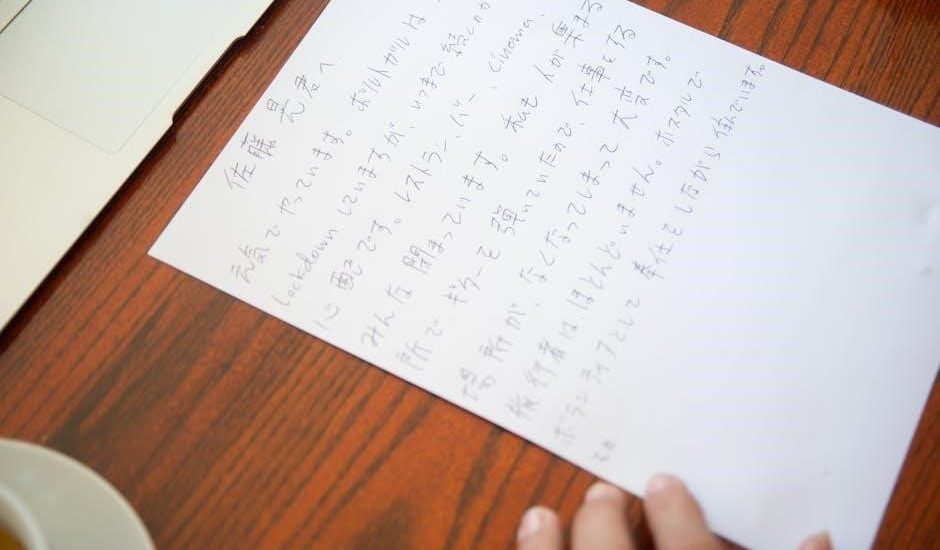Japanese grammar is a fundamental aspect of mastering the Japanese language, offering unique structures and rules that differ significantly from Western languages. This guide provides a comprehensive overview of essential grammar rules, including sentence structure, verb conjugations, particles, and politeness levels, serving as a valuable resource for learners at all levels.
Overview of Japanese Grammar Fundamentals
Japanese grammar fundamentals form the backbone of the language, introducing key concepts like sentence structure, particles, and verb conjugations. Unlike English, Japanese follows a Subject-Object-Verb (SOV) order, with particles marking roles and relationships. Verbs are conjugated for tense and politeness, and the language distinguishes between formal and informal speech styles. Mastery of these basics is essential for clear communication, providing a solid foundation for further learning. Resources like PDF guides and online tools offer structured approaches to understanding these principles effectively.

Japanese Sentence Structure
Japanese sentences follow a Subject-Object-Verb (SOV) order, differing from English’s SVO structure. Particles mark roles, and verbs typically appear at the sentence end, aiding clear communication.
Subject-Object-Verb (SOV) Word Order
The Japanese language follows the Subject-Object-Verb (SOV) word order, unlike English’s Subject-Verb-Object (SVO) structure. In this pattern, the subject is followed by the object, with the verb placed at the end of the sentence. For example, “David saw the bus” becomes “David the bus saw.” This structure may feel unfamiliar at first, but it is consistent and logical. Particles like は (wa) and を (o) help mark the subject and object, making sentences clear. Understanding SOV is crucial for forming correct sentences in Japanese.
Role of Particles in Sentence Formation
Particles are essential in Japanese grammar, serving as markers that define the roles of words within a sentence. Common particles like は (wa), が (ga), and を (o) indicate the subject, object, and other grammatical relationships. For instance, は (wa) often marks the topic, while が (ga) identifies the subject in a sentence with a verb. Particles also convey grammatical functions such as direction, location, and manner, ensuring clarity and precision in sentence formation. Mastering particles is vital for constructing grammatically correct and meaningful Japanese sentences.
Verb Conjugations in Japanese
Japanese verbs are categorized into groups with specific conjugation patterns, including Ichidan, Godan, and irregular verbs. Understanding these patterns is crucial for accurate communication in Japanese.
Basic Verb Tenses: Present and Past
In Japanese, verbs primarily exist in two tenses: present and past. The present tense indicates an ongoing or general action, while the past tense denotes completed actions. Verbs are conjugated by modifying their endings. For example, the verb べる (taberu) becomes べます (tabemasu) in the present polite form and べました (tabemashita) in the past polite form. This system allows for clear and concise expression of time in sentences, with additional context provided by adverbs or auxiliary words when needed.
Verb Groups: Ichidan, Godan, and Irregular Verbs
Japanese verbs are categorized into three main groups: Ichidan, Godan, and irregular verbs. Ichidan verbs, such as べる (taberu), end with る (ru) and follow simple conjugation rules. Godan verbs, like ぐ (oyogu), end with う (u) and have five distinct conjugation patterns. There are only two irregular verbs, する (suru) and くる (kuru), which do not fit standard conjugation rules. Understanding these groups is essential for mastering Japanese verb conjugations and constructing accurate sentences.

Particles and Their Functions
Particles are essential grammatical markers in Japanese, indicating roles and relationships within sentences. They include は (wa), が (ga), and に (ni), which clarify subjects, objects, and other grammatical functions, ensuring clear communication.
Common Particles: は (wa), が (ga), お (o), に (ni)
The particles は (wa), が (ga), お (o), and に (ni) are crucial in Japanese grammar. は (wa) marks the topic of a sentence, while が (ga) indicates the subject, especially in clauses with new information. お (o) is used for emphasis or in polite expressions, and に (ni) denotes direction, location, or time. These particles help clarify sentence structure and meaning, making communication precise and effective.
Advanced Particles for Complex Sentences
Advanced particles like として (to shite), にて (nite), and のに (no ni) enable the construction of complex sentences. These particles connect clauses, expressing causality, purpose, or contrast. For example, として indicates a role or function, while にて specifies a location or means. のに links contrasting ideas, adding depth to narratives. Mastering these particles enhances sentence complexity and nuance, essential for advanced communication in Japanese.

Politeness Levels and Honorifics
Politeness in Japanese is expressed through honorifics and speech styles. Sonkeigo (respectful language), kenjougo (humble language), and teineigo (polite language) are essential for proper communication, reflecting social hierarchy and respect in interactions.
Formal vs. Informal Speech Styles
Japanese distinguishes between formal and informal speech, with formal language used in professional settings, with honorifics and polite verb forms, while informal speech is reserved for close relationships, lacking such formalities; This distinction is crucial for appropriate communication.
Honorifics: Sonkeigo, Kenjougo, and Teineigo
Japanese honorifics are divided into sonkeigo (respectful language), kenjougo (humble language), and teineigo (polite language). Sonkeigo expresses high respect, kenjougo reflects humility, and teineigo is polite without extreme formality. These forms are essential for conveying respect and social hierarchy in communication, particularly in formal and professional contexts. Mastering them is vital for fluent and appropriate expression in Japanese.
Conditional and Modal Expressions
Conditional and modal expressions in Japanese convey nuances like possibility, necessity, and obligation. They add depth to sentences, enabling precise communication of intent and context.
Expressing Conditions: If, Unless, etc.
Japanese uses specific particles and structures to express conditional statements. The particle と (to) is used for “if” in straightforward conditions, while なら (nara) expresses hypothetical or uncertain situations. For example, がらなければきます (ame ga furanakereba ikimasu) means “If it doesn’t rain, I will go.” Conditional clauses often appear with ば (ba) for different types of conditions, such as れなくば (okurenakuba) for “if you are not late.” Mastering these structures is essential for forming complex sentences.
Modal Expressions: Ability, Permission, and Necessity
Japanese modals convey ability, permission, and necessity using specific verbs and particles. For ability, できる (dekiru) is used, e.g., をすことができます (nihongo o hanasu koto ga dekimasu) meaning “I can speak Japanese.” Permission is expressed with てもいい (te mo ii), as in っててもいいですか (itteinokotemo iidesuka) for “Is it okay to go?” Necessity uses なければなりません (nakereba narimasen), like しなければなりません (benkyō shinakereba narimasen) meaning “I must study.” These expressions enhance sentence complexity and nuance, essential for advanced communication.
Plurality and Quantity in Japanese
Japanese expresses plurality using counting systems and numerical classifiers like (nin) for people or (hon) for objects. Particles like たち or ら also indicate plurality, while no verb changes are needed for number agreement.
Counting Systems and Numerical Classifiers
Japanese uses numerical classifiers to count objects, with specific classifiers like (hon) for long items and (nin) for people. For example, 1のペン (one pen) or 2の (two students). These classifiers are essential for accurate counting and vary based on the object’s shape or category. While the system may seem complex, it is highly logical and consistent, aiding in clear communication. Mastering numerical classifiers is crucial for fluency in Japanese.
Expressing Plurality with Particles and Suffixes
In Japanese, plurality is often expressed through context and specific particles rather than altering the noun itself. Suffixes like たち (tachi) and 々 (nin nin) can indicate plurality, typically for people or animate beings, such as たち (tomodachi-tachi) for “friends.” Numerical classifiers like (hon) for objects or (nin) for people are used to count and imply plurality, e.g., 2のペン (ni hon no pen) for “two pens.” These elements help clarify plurality in a sentence, especially when context alone isn’t sufficient.
Common Japanese Sentence Patterns
Japanese sentence patterns rely on particles to mark roles, with a basic structure of subject-object-verb. Common patterns include question forms and negative sentences, using particles like は and が to guide meaning and context.
Basic Sentence Structures for Beginners
Mastering basic Japanese sentence structures is essential for beginners. The fundamental pattern follows the Subject-Object-Verb (SOV) order, differing from English’s SVO structure. For example, “David saw the bus” becomes “David wa basu o mita;” Particles like は (wa) and を (o) indicate the subject and object, respectively. Simple sentences often include a topic marker and a verb at the end. Understanding these basics helps build a strong foundation for more complex constructions later. Consistent practice with examples ensures clarity and correctness in sentence formation.
Complex Sentences with Multiple Clauses
Complex Japanese sentences involve multiple clauses, often linked using specific particles and conjugations. These sentences combine ideas by connecting clauses with て (te), し (shi), or ば (ba). For example, “If I study, I will understand” becomes “するなら、かるだろう” (Benkyō suru nara, wakaru darō). Such structures require mastering clause linking and conditional expressions. Practice with example sentences and resources like PDF guides or online tools can help learners grasp these patterns effectively and improve their ability to express nuanced ideas in Japanese.

Resources for Learning Japanese Grammar
Discover comprehensive Japanese grammar PDF guides and online tools offering detailed lessons, exercises, and examples. These resources cater to all levels, from beginners to advanced learners.
Recommended PDF Guides and Online Resources
Enhance your learning with top-rated Japanese grammar PDF guides and online platforms. Tae Kim’s Guide offers detailed explanations, while JLPT Sensei provides exam-focused materials. Websites like 90DayJapanese and Japanesepod101 offer interactive lessons, practice exercises, and audio examples. Additionally, resources like WaniKani and textbooks such as “Genki” and “Minna no Nihongo” cater to both beginners and advanced learners, ensuring comprehensive coverage of grammar rules, sentence patterns, and cultural insights.
Practice Exercises and Interactive Tools
Reinforce your grammar skills with engaging exercises and tools. Websites like JLPT Sensei and WaniKani offer quizzes, flashcards, and progress tracking. Apps such as Tae Kim’s Study Materials provide interactive verb conjugation drills. Additionally, platforms like 90DayJapanese feature writing prompts, sentence formation exercises, and spaced repetition systems (SRS) for effective learning. These resources cater to all proficiency levels, ensuring practical application of grammar concepts and helping learners master Japanese through hands-on practice.





